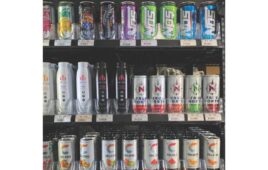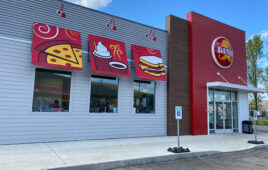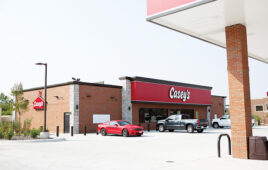Why waste anything—especially energy?
Newer technologies and out-of-the-box thinking are helping trim energy costs, while plain old smart management can bring additional savings.
“Most of the time, quite frankly, store operators haven’t even done the most basic stuff that could be saving them quite a bit on operating costs,” lamented John Noel, president of Energy & Environment LLC in Atlanta, which offers efficient lighting consulting and contracting services. “We can talk about sexy technology all day long, but it doesn’t matter if you haven’t done the basics.”
A bit of innovation, however, still doesn’t hurt. For example, a BP station in Baltimore recently installed a “living roof” containing soil and plant materials to absorb rainwater. The store also uses high-efficiency lighting and recycles water used in its car wash. SeQuential, a c-store in Eugene, Ore., is using passive solar architecture and a solar array canopy to help reduce energy costs. The company operates and distributes biofuels to 25 stores throughout Oregon.
The Douglas County Farmers Co-Op, a convenience store group in Roseburg, Ore., recently added a pair of retrofits in order to reduce its energy costs. The store switched from metal halide bulbs that consumed 480 watts to T-5 fluorescent bulbs that use just 265 watts. The change will mean an estimated 30% drop in electrical costs for lighting, as well as improved lighting and less heat in the summertime.
The updated lighting was supported through Oregon’s Business Energy Tax Credit and an incentive payment from the Energy Trust of Oregon. Both the store and the warehouse now use the improved indoor lights. The ROI is expected to take about three years.
Much can be learned from QSRs, as well. For example, a Chicago McDonald’s unit built specifically to test energy-saving and green technologies includes a permeable pavement that slows and cleans rainwater that might normally pollute city waterways; high-efficiency appliances; an underground cistern used to collect rainwater (later used for landscaping) and a roof garden for insulation.
The Chicago unit also uses skylights and energy-saving fixtures containing light-emitting diodes. Low-flow urinals and toilets add still more savings.
Here are more ways c-store operators can be more energy-efficient:
Lighting
“Some of the best opportunities for energy efficiency would be from lighting,” said Steve Bower, senior consultant for Optimal Energy in Bristol, Vt. High-performance T-8 lighting or, in stores with higher ceilings, T-5 lighting can save lots of energy.
LED (light-emitting diode) wall packs for security lighting are “a big thing,” Noel said. “They don’t give out and they have very long maintenance periods.”
Many retailers are going with LED lighting for signage. The LEDs are expensive, but have two advantages. First, maintenance costs collapse because the lamps just don’t give out. And they perform better in cold weather so they won’t flicker or get dimmer. “Using them allows operators to go from hogs to a very efficient light source,” Noel said.
In moving through the Southeast Noel said he is constantly surprised, particularly in the convenience store market, because the facilities are relatively small, but they don’t really think about how big a portion of their electric bill lighting can be.
“There are lights in the canopy area and fluorescent lights over their gas pumps that are high-output (HO) T-12’s, which are all energy hog’s,” Noel said. “They burn out and quickly get replaced, without store operators even pausing to consider a lower-cost alternative.”
Frankly, Noel added, a lot of people are scared off by the dollar figure when it comes to things like LED flood and security lighting and electronic ballasted HIDs (high-intensity discharge lights).
“Many convenience stores that are energy hogs are mostly using antiquated technology. Not mostly, almost universally,” Noel said.
Reach-In Coolers
Additional savings can come from more efficient lighting in display coolers. Many have inefficient lighting that “generates a lot of heat,” Bower said. “When you put in LED lighting, which generates almost no heat, you’re not having to cool the heat from the lighting in your display coolers.”
Display doors on reach-in coolers often have heaters to prevent fogging of the glass. “Then you’ve got to cool the heat from heating the door,” Bower said. “There is a newer technology that involves putting a film on the door to keep it from fogging up. As a result, you don’t have to spend money heating the door.”
Geothermal
“Because convenience stores have a lot of refrigeration they can implement economizers,” said Bower, “which bring in cold air from the outside for their refrigeration.” There is, he added, “a lot of potential for geothermal, using ground-source heat pumps for refrigeration. A portion of the refrigeration can be handled by cold water in the ground. In fact, I know of a convenience store that put in one of those systems here in Vermont last year with outstanding results.”
Ground-source heat pumps and geothermal in general have a lot of potential, but they also have a higher initial cost and a longer payback period. “Convenience stores are such a competitive business that it’s hard to convince somebody to do something with an eight- or 10-year payback period,” Bower said.
HVAC
Heating, venting and air conditioning (HVAC) costs can be reduced by using ground-source heat pumps. “You drill a well down to deeper, colder ground water,” Bower explained. “Then use that as a chiller for either air conditioning or refrigeration. These systems can also be used in colder climates to gather heat.”
Air-side economizers can save energy in buildings by using outside air to cool indoor space. They can reduce HVAC energy costs in cold and temperate climates while potentially improving indoor-air quality. Some, though, aren’t appropriate in hot or humid climates.
Douglas County convenience store cut its HVAC costs through the introduction of three air-movers. The one-third horsepower units are suspended from the ceiling and combine cold and warm air to aid circulation. A side benefit can be an approximately 50% decrease in electrical usage and natural gas usage for heating.
Solar Energy
Retailers investing in solar panels as power supplements understand the serious cost benefits.
“These progressive companies know they can’t run the whole building on solar power,” said Dan Butler, vice president of merchandising and retail operations for the National Retail Federation. “But if they can reduce their longterm costs it’s worth it.”
Monitors
“A lot of the newer technologies have to do with software that helps you monitor usage more accurately and that flags problems more efficiently so that you can respond more quickly,” Butler said.
Remote, Internet-based controls can provide big savings, too. Convenience store chains like Rutter’s Farm Stores in Pennsylvania have been using this technology for years.
Insulation
Another effective method for reducing air conditioning and heating costs is blanketing walls and ceiling with spray foam and encapsulating the upper portion of the building.
“It’s not sexy and innovative, but it’s extremely effective, and if you forget to do it, you’re going to pay for that mistake for the life of the building,” Bower said.
Other recommendations from the panel of experts included low-flush toilets, which Butler said, “is the same thing as energy efficiency.”
Plus, seek tax credits. Heating water with a solar/thermal system, for example, can provide credits at both the federal and state level.
Walk-In Coolers/FreezersThose operators with walk-ins should be aware of some changes that went into effect on the first of the year. The Federal Energy Independence and Security Act of 2007, which calls for reducing energy dependence and carried a Jan. 1, 2009 implementation date, mandates a number of new design requirements for walk-in coolers and freezers. According to The Manitowoc Co. they include: • Automatic door closers that close the door fully from within one-inch of closed, unless the door is wider than 3 feet 9 inches or taller than 7 feet; • Strip doors, spring-hinged doors, or other methods of minimizing air infiltration when doors are open; • Upgraded wall, ceiling, floor and door insulation for some models; • Evaporator fan motors less than one horsepower require electronically commutated or three-phase design; • When used without a device capable of turning the interior lights off within 15 minutes of being unoccupied by people, all interior fixtures must use a light source with an efficacy of 40 lumens per watt or more including ballast losses; • Transparent reach-in doors for walk-in freezers must be triple pane glass with either heat-reflective treated glass or gas fill. |




